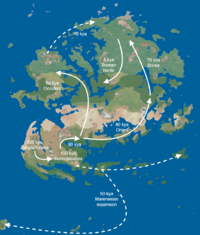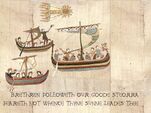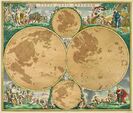History of migration on Eurth: Difference between revisions
m (→Post-Classical migrations: added Buran) |
m (→Prehistoric migrations: two waves) |
||
| Line 32: | Line 32: | ||
Another, more controversial theory about the peopling of the [[New Wurld]] theories that humans could have migrated by boat from northwestern [[Europa (continent)|Europa]] to [[Argis]], following the drifting ice of the North [[Adlantic Ocean]]. This theory is quite popular in [[Dolchland]], but no serious scientists give this idea any credence.{{citation needed}} | Another, more controversial theory about the peopling of the [[New Wurld]] theories that humans could have migrated by boat from northwestern [[Europa (continent)|Europa]] to [[Argis]], following the drifting ice of the North [[Adlantic Ocean]]. This theory is quite popular in [[Dolchland]], but no serious scientists give this idea any credence.{{citation needed}} | ||
WIP | |||
* First wave is always slow, because there is nothing to build upon and everything has to be started. For example: [[Azano-Marenesian peoples]] in [[Alharu]]. Stick around the coast, then move inland. | |||
* Second wave is faster, allows trade, because at least some ports exist. For example: [[Memopotamia]]ns in [[Marenesia]]. Only coastal explorations. | |||
=== Classical migrations === | === Classical migrations === | ||
Revision as of 01:16, 16 July 2023

The history of euman migration refers to the movement by eumans from one geographical area to another with the intentions of settling, permanently or temporarily, in a new location. The movement is often over long distances and from one country to another, but internal migration is also possible; indeed, this is the dominant form glubally.
Migration involves significant cultural, economic, political, and social change for both the migrants themselves and the populations in the destination location. The driving forces behind migration include economic, social, political, and environmental factors.
History
The history of euman migration is a long and complex one, dating back to the Stone Age. Over time, eumans have spread to all corners of the glube, following a variety of routes and motivations.
Prehistoric migrations
The history of euman migration extends back to the earliest periods of euman history. One of the earliest human migrations was the out-of-Azania migration, which occurred between 500,000 and 100,000 years ago. The prehistoric migration of the Homo genus out of Azania is considered to be the first significant instance of euman migration. This migration saw modern humans (Homo sapiens) leave Azania and spread across Memopotamia, Amutia, and eventually the rest of Europa.
Another major euman migration was the maritime spread of Azano-Marenesian peoples across the Eurth during the Palaeolithic period. During the last glacial maximum (50 kya), the sea level was probably more than 110 meters lower than today. When glaciers advance and the climate is colder, glaciation occurs and sea levels drop. And when the climate is warmer, glaciers retreat, and sea levels rise, ushering in an interglacial period which is what we’re in right now.[1] The first humans used this lower sea level to reach Marenesia and then Alharu. It is believed that eumans crossed this area in canoes. This ocean crossing is one of eumanity’s important early achievements, even if it’s wrapped in mystery because no written records of this Cigarun civilization have been discovered. The migration was a significant event, as it was the first time that eumans had settled on a continent that was completely isolated from other landmasses. Heading south from Noble Nykia, with assistance from ocean currents and prevailing winds, there exists an advantageous ‘ocean highway’ with ideal conditions for island hopping.[2]
- 80,000 BCE: Azano-Marenesian peoples move to Meteorolas.
- 50,000 years ago: Azano-Marenesian peoples move to Marenesia.
- 15,000 years ago (13,000 BCE): Azano-Marenesian peoples move to Alharu.
- 10,000 years ago (8,000 BCE): Azano-Marenesian peoples move to Aurelia and Argis.
Subsequently, the advent of agriculture led to substantial population movements in many parts of the wurld.
- XXXX BCE: Transadlantic trade to Memopotamia.
- 4000 BCE: Proto-Xaraian tribes in the 4th millennium BCE. Spread across Central Argis in what is now modern-day Ahrana and parts of east Dniester, the Proto-Xaraian tribes were strategically positioned in between the Mediargic and Canamo seas.
Another, more controversial theory about the peopling of the New Wurld theories that humans could have migrated by boat from northwestern Europa to Argis, following the drifting ice of the North Adlantic Ocean. This theory is quite popular in Dolchland, but no serious scientists give this idea any credence.[citation needed]
WIP
- First wave is always slow, because there is nothing to build upon and everything has to be started. For example: Azano-Marenesian peoples in Alharu. Stick around the coast, then move inland.
- Second wave is faster, allows trade, because at least some ports exist. For example: Memopotamians in Marenesia. Only coastal explorations.
Classical migrations
- 1200 BCE: Medanese traders travelled westward across the Oriental Ocean and beyond. Even though the Strait of Saeida were supposed to be impassable, the little ships were brave enough to go through them and sail into the open Adlantic Ocean. From there, they went to Yuropa to get ivory and gold.[3] Their trade routes might have reached as far as Tagmatium, or perhaps even beyond.
- 900 BCE:
 Proto-Aloorian culture in Europa starts as various smaller groups are forced towards the sea by larger clans and realms. The proto-Aloorians focus on seafaring and the sea in general, seeing it as a new opportunity and a way to get away from their enemies.
Proto-Aloorian culture in Europa starts as various smaller groups are forced towards the sea by larger clans and realms. The proto-Aloorians focus on seafaring and the sea in general, seeing it as a new opportunity and a way to get away from their enemies. - 800 BCE
 First evidence of a single proto-Aloorian language, further aiding trade and knowledge sharing between the various areas. Organised religion starts playing a role as a singular, unified language enabled sharing the oral traditions of the various groups.
First evidence of a single proto-Aloorian language, further aiding trade and knowledge sharing between the various areas. Organised religion starts playing a role as a singular, unified language enabled sharing the oral traditions of the various groups. - 500 BCE:
 Some untold disaster forces proto-Aloorians groups to come together and merge, heavily increasing the population density and forcing creative solutions for homelessness among new inhabitants.
Some untold disaster forces proto-Aloorians groups to come together and merge, heavily increasing the population density and forcing creative solutions for homelessness among new inhabitants. - 441 BCE: Great Departure (Utgang) of Sjådska to Altaria
- 59 CE:
 An Aroman merchant vessel, blown off its course, lands in Marenesia. Its wreck was found at the bottom of $Name Bay near Deopolis, Salvia.[4] Amphoras found in the ship are in fact similar in shape to jars produced in kilns at Tellakois, on the west coast of Adaptus.
An Aroman merchant vessel, blown off its course, lands in Marenesia. Its wreck was found at the bottom of $Name Bay near Deopolis, Salvia.[4] Amphoras found in the ship are in fact similar in shape to jars produced in kilns at Tellakois, on the west coast of Adaptus. - 125 CE: Great Aroman Migration to Sanctum Imperium Catholicum.
Post-Classical migrations
- 704:
 The Siege of Arome ends when Pope Calrissius I capitulated and fled Tagmatium to Salvia, which marks the Enlightened Aroman Church becoming the new State Church of Arome.
The Siege of Arome ends when Pope Calrissius I capitulated and fled Tagmatium to Salvia, which marks the Enlightened Aroman Church becoming the new State Church of Arome. - 760-880: During the Mikoto period (c. 760-880), the Orinese Empire reached the height of its power. With trade booming, the dynasty financed an exploratory expedition into the Oriental Ocean, which returned with reports of a great current flowing through the ocean. Seeing an opportunity for wealth and adventure, the Empress Yomiro II raised a fleet of 1,000 ships and prepared to find and settle whatever new land this current might sweep her to. She left her sister Ahe IV in charge of the empire and dropped her sails. Neither Empress Yomiro II nor any of her ships were ever heard from again. Yet this unfortunate occurrence paved the way for Orioni's golden age.
- 887:
Olrik Naddoddson is banished from Thelarike “because of some killings”. He and his family lead a Buranian exploration into the Adlantic Ocean.
- 890 :
 An Ateenian expedition in Eastern Aurelia lands in the territory of modern Louvier. They set up a short-lived colony and raid the natives. After being decimated by sicknesses, they leave.
An Ateenian expedition in Eastern Aurelia lands in the territory of modern Louvier. They set up a short-lived colony and raid the natives. After being decimated by sicknesses, they leave. - 900-1400: The tenth century was the start of the Little Ice Age, a disruption in glubal climatic patterns. This resulted in generally cooler and wetter temperatures. These strongly affected the rainy season. In the fourteenth century, this manifested into a general trend of intense colds and snowfall in the polar steppes, irregular droughts in temperate climates, and seemingly unending rainfall in subtropical areas.[5] It had a significant impact on farming harvests. This, in turn, led to increased conflict, human migration, spread of disease. Certainly not a good time to be alive.
- 1250: Migration of Buran from the Central Europan Steppes.
Early modern migrations
- 1400-1700: The Age of Reconnection is a broad designation for a period of increased overseas exploration. It's marked by emerging globalisation. Many lands previously forgotten during the Post-Classical Age were re-discovered. Since the majority of these lands were already populated, explorers were often seen as invaders.
- 1535 :
 Lysian explorer Clément du Vent lands in Northern Aurelia. He founds the town of Saint-Philippe by going up the Saint-Pierre river, establishing the colony of Lysian Louvier.
Lysian explorer Clément du Vent lands in Northern Aurelia. He founds the town of Saint-Philippe by going up the Saint-Pierre river, establishing the colony of Lysian Louvier. - 1540:
 The island of Seylos is settled by the exiled King Harold and his supporters.
The island of Seylos is settled by the exiled King Harold and his supporters. - 1590:
Iberic Revolution begins; commonly called L'Malcisma in Tacalan. In 1593, hundreds of thousands of Iberics flee in a diaspora event known as The Gran Viatge.
- 1620:
First Iberics arrive in Argis; Deiargon's Fleet settles what will be known as the Iverican Peninsula. The first Iverican Republic is founded.
- 1690:
 Iverica begins its colonisation of Western Alharu by founding a colonial outpost in Concepción in modern-day Mauridiviah.
Iverica begins its colonisation of Western Alharu by founding a colonial outpost in Concepción in modern-day Mauridiviah.
Modern migrations
In more recent history, large-scale migrations have continued to shape the wurld.
WIP: here are some examples
- 20th century immigration
- displacements caused by both major conflicts
- evolving glubal refugee crises
Causes
Migration occurs due to a variety of reasons. Push factors force individuals to leave their current location, while pull factors attract individuals to a new location.
- Push factors: Push factors are reasons why people leave an area, which include but are not limited to, lack of jobs or opportunities, famine or drought, political or religious conflict, and natural disasters.
- Pull factors: Pull factors are reasons why people move to a specific area. These include better job opportunities, political and religious freedom, and the presence of family members in the destination location.
Effects
Migration has various effects on both the departure and destination locations. On one hand, it can stimulate economic growth in the destination location and relieve pressure on resources in the departure location. On the other hand, it can lead to social tensions and challenges related to integration in the destination location, while the departure location may suffer from a lack of skilled workers and a decrease in population.
Types
- Internal migration: This involves eumans moving within the same region or country. It often occurs due to economic factors, such as seeking employment or moving to cities for better life opportunities.
- International migration: This refers to eumans moving from one country to another. International migration can be voluntary, with individuals seeking better opportunities, or forced, such as in the case of refugees fleeing war or persecution.
- Seasonal migration: This is a form of migration in which eumans move according to the seasons, typically for work reasons, such as agricultural or tourism jobs.
Future
The future of euman migration is influenced by factors such as glubal warming, political instability, and economic development. Climate change, in particular, is expected to drive significant euman displacement in the future. At the same time, increasing glubalisation and technological advancements are making it easier for eumans to move across the globe, suggesting that migration will remain a key aspect of eumanity's future.
See Also
- (Some AN office)
- (Number of refugees per country on Eurth)
- AN High Commissioner for Refugees (ANHCR)
- History of Eurth
References
- ↑ What is Climate Change? by Crash Course Geography (3 May 2021)
- ↑ So who discovered Argis, Alharu and Aurelia? by Orioni (22 May 2018)
- ↑ Campbell, Joseph (2008). The hero with a thousand faces. Canada: Princeton University Press. p. 10. ISBN 978-1-57731-593-3.
- ↑ Walter Sullivan, Rio artifacts may indicate Roman visit, The New York Times, 10 October 1982
- ↑ How the Mongols Lost China by Kings and Generals (9 January 2022)



